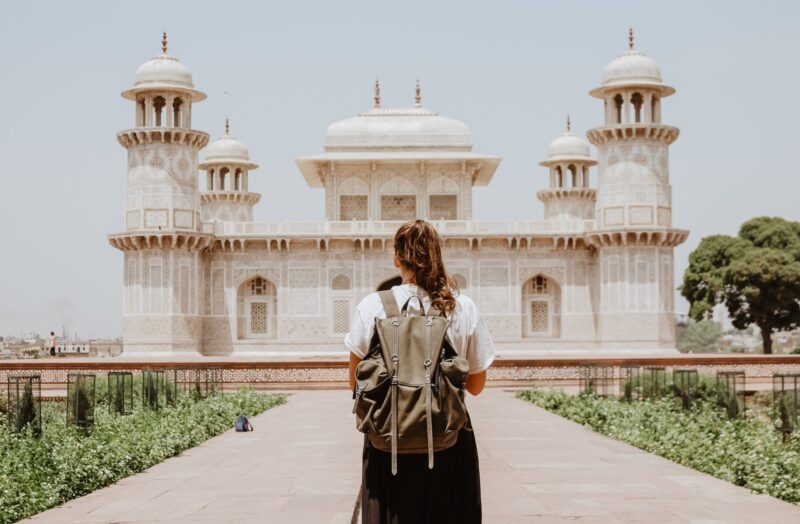Have you been bit by the travel photography bug? Looking back on your favorite travel photos is the next best thing to actually being there. The good news is that you don’t need a fancy camera to take amazing photos. You can use your iPhone or whatever phone you carry with you. So if you’re ready to elevate your travel photos, follow these creative tips and ideas.
What can make your travel photos more interesting?
Great travel photos transport the viewer to a different time and place. Stunning landscapes of beautiful nature and famous sights are just the beginning. What makes a travel photo interesting is capturing the essence of a place with creative compositions, angles, and details that not everyone gets to see. The most interesting travel photography feature:
- A sense of scale and grandeur
- Details of everyday life
- Behind-the-scenes views of famous places
- Local cultures, food, and clothing
- Sweeping views of places that aren’t tourist destinations
- Creative compositions of popular locations
Our top tips for creative travel photography
Whether exploring road trip photography, snapping travel landscapes, or capturing urban street scenes, your travel photos should showcase the unique aspects of your trip that can’t be captured by anyone else. Here are our top tips and ideas for amazing travel photography.
1. Create a sense of scale in your travel photos
Many photo-worthy landscapes feature larger-than-life scenes that leave you in awe of the immense grandeur and beauty. But when you snap a picture, it just doesn’t always do the scene justice. Instead of simply capturing the scene as you see it in a travel landscape photo, try to evoke a sense of scale within your scene. The easiest way to do this is by placing a person in your shot so that the true enormity of the landscape is captured in your photo. Photographing animals, vehicles, buildings, and trees will also help to add scale to your travel photos.
2. Don’t center the horizon line in your travel photography landscapes
Using a centered horizon line in your travel landscapes may feel like the right thing to do, but in reality, it often just cuts your scene in half and makes your photo less interesting. Instead of centering the horizon, take a good look at your scene and give more space to the part that you find more interesting.
If, for example, you’re looking at a gorgeous sunset with interesting colors and clouds, leave more room for the sky in your photo. If the foreground features cool plants, rocks, and buildings but the sky is cloudless and blue, emphasize the more interesting landscape. Can’t decide between the two? Split the difference and create two photos with the horizon placed differently in each one, then decide which option works best.
3. Use leading lines for your road trip photos
Road-tripping is a special kind of travel and, as such, requires a special kind of photography. The road itself is an integral part of the journey, so it’s worth the added effort to capture it in a way that ensures you’ll always remember where you’re going and where you’ve been. The concept of “leading lines” simply refers to a real or imaginary line that leads the viewer’s eye toward the main focal point of your photo. In the example above, the road takes you right to the center peak, creating a memorable impact. If you’re traveling with a friend, it can also be fun to include your road trip vehicle in a few shots.
4. Capture an interesting foreground in your travel photography
Here’s a quick way to add interest to your travel landscapes: Instead of focusing solely on that distant mountain or waterfall, look for a way to include the foreground in your photo, whether it’s a patch of wildflowers or a cluster of small rocks. Not only does this create a more impactful image, but it’s also a great exercise to help you learn to “see” the photo when composing your shots. You may have to put in some extra legwork to explore the landscape more fully, but it’s worth the effort.
5. Shoot during the blue hour or golden hour
Photography is all about capturing the light as it interacts with the scene in front of you, but not all light is created equal. When shooting travel photos, you will find that both the golden hour and blue hour are ideal for providing amazing light that will transfer to your photos. The golden hour is the hour just after sunrise and just before sunset when the tones are warm and bright. And the blue hour is the hour before sunrise and the hour after sunset when the warmth of the sun is absent and the world is bathed in subdued light with cool overtones.
6. Fill the frame with your subject
When you fill the frame, you are using all the available space within your photo to capture your subject, whether it’s a person, a building, or a collection of fruits and vegetables at the farmers’ market. To fill the frame, you have to get in close, giving your viewer a more intimate portrait of your travels.
7. Capture the small details of a scene
It’s so easy to get taken in by new places when you’re traveling — and easy to overlook the small details that make a place special. When you’re traveling to a new destination, don’t forget to pay attention to the little things like the sights, sounds, and details that make the location unique. Famous landmarks are unforgettable, with or without a photo. But those impromptu detours through the park or down a side street? Your creative travel photo will help you remember those journeys forever.
8. Shoot after dark
There is a stark contrast between popular destinations as seen during the day compared with after dark. When you stick to taking all your travel photos during daylight hours, you miss half the fun! So set aside a few nights to explore your destination after dark. Modern iPhones have sensors that allow them to capture every bit of light for incredible night shots (if you have Night mode, use it!). You’ll soon discover hidden compositions that the average tourist will miss.
9. Capture travel photography from a new angle
When we take photos, we tend to shoot at eye level because it’s comfortable and easy. While there’s nothing wrong with shots taken from this angle, it means we miss some of the most interesting compositions. Here’s a little challenge for you when taking travel photos. Instead of holding your camera at eye level to explore your destination, look for new angles to shoot from. Squat down low to capture the view from the perspective of a small child. Or hold your phone over your head, or use a selfie stick, to capture the scene from above. These small changes in perspective can create a big impact in your travel photography.
10. Take photos of people interacting with the landscape
Creative portraits have a way of invoking a dramatic response from your viewers. While traveling, look for ways that you can capture people interacting with the environment. This is easy to do in cities where throngs of people are going about their daily lives. In rural environments, you may need to seek out such scenes at farms, markets, or parks. The photo above was taken at a cattle ranch in New Mexico.
11. Take photos of the things you love
Our last tip for taking amazing travel photos is simple — photograph the things that give you joy. Photography is a creative endeavor with some technical know-how thrown in. And as a photographer, it can be overwhelming to attempt to learn all the best techniques, keep up with the latest gadgets, and remember to share your photos on social media.
To counterbalance the frustrations of photography, focus on doing what you love. Don’t stress out about getting up to take sunrise photos if you’re not a morning person. And if taking photos of your dog during your travels brings you joy, do it! You’ll likely find that the photos you love most are those you loved taking!
Taking amazing travel photos isn’t difficult, provided you spend a little time scouting your location and getting creative with your compositions. Remember, the goal isn’t to recreate the photos you see in magazines but to capture the essence of your own trip so that you have your own beautiful photographic memories. And if you’re also trying to make your photos of sunsets more creative, check out the sunset photography guide we published earlier.



